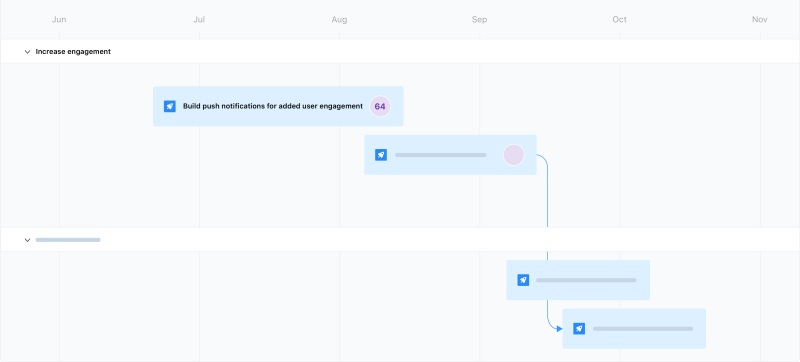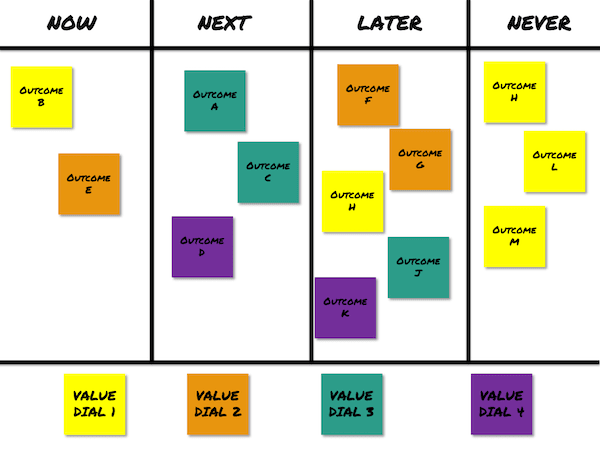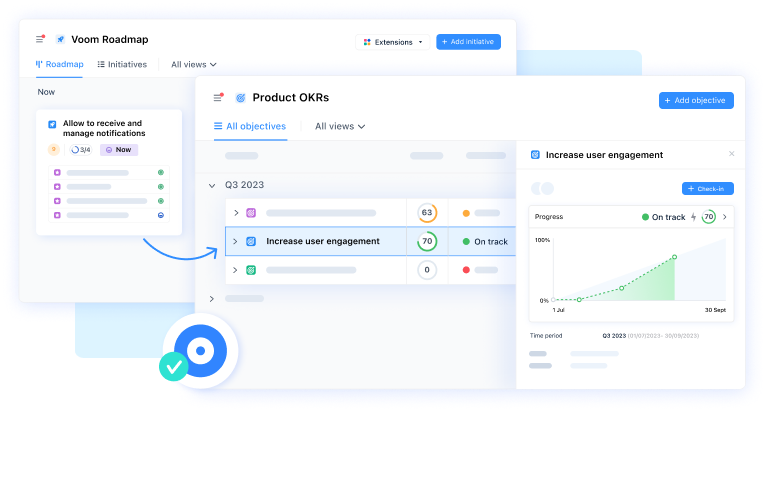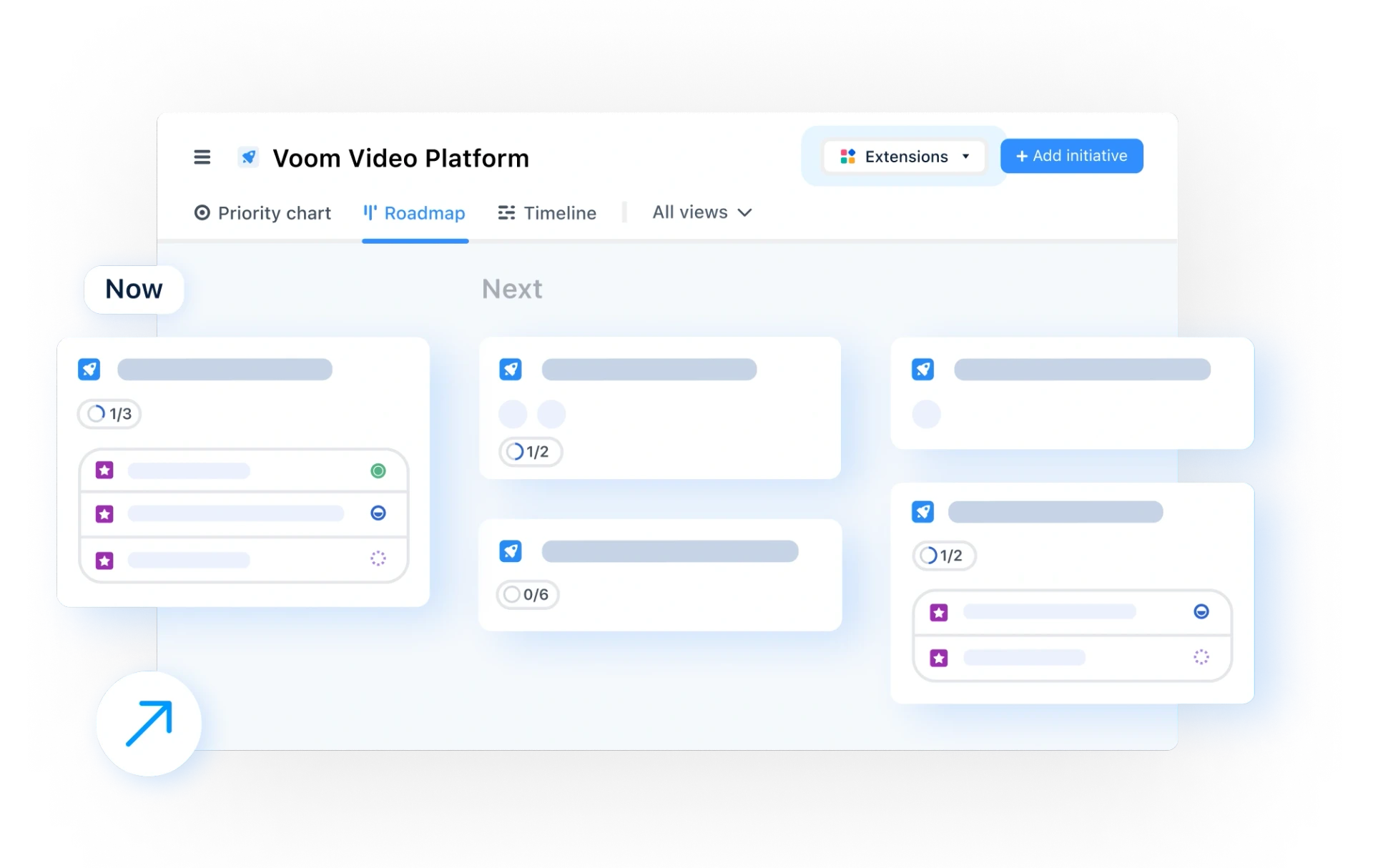Suppose you’re trying to understand how OKRs and roadmaps are related and how you can align the two. In that case, it helps to understand what the two concepts are.
If you do a google search for OKRs and roadmaps, you’ll find articles taking the tried and true (you could say tired) formulation of OKR vs. roadmap.
The two techniques are not things to be contrasted. They can be complimentary.
OKR’s help you put some metrics around the problem you’re trying to solve. Roadmaps help you communicate the things you’re going to use to reach your outcome.
To truly understand how the two fit together, it’s best to get on the same page about what OKR’s and roadmaps are so we can then look at how they work together.
What are OKRs
OKR stands for “objectives and key results.” It’s a goal-setting system that describes the outcome you’re trying to accomplish and how you know when you’ve reached that outcome.
The objective is a qualitative description of what you want to achieve. It’s possible to have broad objectives at the corporate level, such as increase revenue, and more focused objectives at a product level such as increased subscriptions or increased subscription renewals.
The key results are a set of metrics that measure whether you’ve met your objective. The key results are additive, meaning that you need to make progress toward all of them (at least 70%) to meet your objective successfully. Multiple key results ensure that you meet your objective without introducing unintended side effects.
You may find it helpful to establish OKR’s at both a business level and a product level. Objectives at a business level typically deal with impacting revenue or profit and build a shared understanding of what the organization wants to accomplish in the upcoming quarter.
Objectives at a product level build shared understanding around the problems that product teams are trying to solve, often in furtherance of a specific business objective. These product level objectives act as leading indicators and indicate whether a team’s actions move it in the right direction.
Applying OKR’s - an example
Let’s consider an OKR for a hypothetical ride-hailing company.
An example business objective might be :
Increase monthly revenue per active rider
And the corresponding key results could be:
Increase monthly net revenue per active rider from $X to $Y
Reduce active rider churn from A% to B%
Increase new monthly active users from C to D.
Note that the combination of key results measures progress on the overall objective and avoids unintended consequences. In this case, the last two key results are there to discourage any actions to increase the revenue per active rider by merely decreasing the number of active riders. You’d hit that objective, but the overall revenue for the company falls.
What are Roadmaps
Roadmaps provide a high-level strategic overview of product development efforts or work toward company-wide objectives.
There are several different types of roadmaps. The exact number depends on whom you ask and how broadly they think of the concept of roadmaps. The outcome-based roadmap is the most appropriate format to align with OKRs.
Why the outcome-based roadmap is the best roadmap to align with OKRs
An outcome-based roadmap consists of a set of columns showing relative time frames. Usually, those columns are labeled Now, Next, and Later.
You may also use a Never column if you need to identify things you aren’t going to do. You may also see a Done column if there’s value in tracking what the team has completed.
The items tracked on the outcome-based roadmap are outcomes the team may deliver. You can also think of these as objectives or problems to solve.

The Now column shows the outcome(s) that your team is actively addressing. You have the most certainty about items in this column. You can describe the solution and provide reasonable estimates when you plan to complete your work.
The Next column reflects the outcome(s) you may attempt to address when you’ve finished the items in the Now column on the outcome-based roadmap. While you’re pretty sure you’ll work on items in this column, conditions may change such that you need to turn your attention to something else. Your product trio of product manager, product designer, and tech lead perform discovery work to understand these items better.
The Later column reflects the outcome(s) you might address someday. This column exists to track outcomes you think may be worthwhile to address someday and don’t want to lose sight of. These outcomes are options for things you may or may not do.
A roadmap shows how you plan to reach your objective (OKRs combined with outcome-based roadmap)
With the above descriptions of OKRs and roadmaps in mind, let’s take a look at how you can use the two techniques in combination to guide an effective product development process.
Assuming your organization has established a business objective in OKR form, use an outcome-based roadmap to track the initiatives you will try to reach that objective.
Ideally, you’ll describe each initiative with a product outcome that ties back to the business outcome. Describe those initiatives in terms of product outcomes to broadly define the initiatives in Next and Later. Only identify specific solutions when you bring an initiative into the Now column. That allows you to craft solutions based on changes you’ve made previously.
Suppose your organization has identified multiple business objectives. In that case, you can track progress toward numerous business objectives by grouping the related product outcomes or color coating the product outcomes on your roadmap.

Here’s an example roadmap for an organization with four business objectives called value dials. The specific initiatives the product team planned are color-coded based on their related business objective.
Aligning OKRs and roadmaps - an example
Think back to the example from earlier.
The product teams at the ride-hailing company determined that the best way to increase revenue per active rider is to increase the number of rides in a month per active rider.
The teams then dive into some discovery work to identify what they could do to cause active riders to take more rides per month. They may use a technique such as Opportunity Solution Tree to guide that exploration and organize their findings.
The teams may find that some opportunities that exist to increase rides per month might include:
Schedule rides ahead of time
Identify preferred drivers
Choose between preferred drivers and the quickest available drivers
Get rewarded for frequent use of the ride-hailing company
Each of those opportunities might have corresponding OKRs that the team can use to measure the success of each idea. Those opportunities become the items they track on their roadmap.
OKRs and Roadmaps can coexist
OKRs explain what you’re trying to accomplish and how you know when you’ve done that. Roadmaps help you communicate the steps you’re going to try to meet that objective.
When you use the two techniques together properly, you’re in a great position to build the right thing for your customers and your organization.

Common challenges when aligning OKRs with roadmaps and how to handle them
While aligning OKRs with your roadmaps can elevate your project management, it can throw a few curveballs your way. Here are a few common problems you might face.
1. Changing priorities
It’s incredibly rare to see priorities stay the same for the entire development cycle, especially with Agile teams. This lack of stability makes maintaining alignment between OKRs and roadmaps difficult.
There is always a chance that teams will miss vital updates and continue working according to your OKR roadmap. This will quickly lead to delays in delivery, poor resource management, and potentially some unhappy employees.
You should maintain regular communication and reviews if you’re using an OKR roadmap on a fast-moving project. This will ensure everyone stays on the same page and that you work towards the right goals.
2. Resource constraints
There’s always a chance your resource availability changes as the project progresses. This can hinder progress toward your OKRs and will have knock-on effects for the final product if you don’t adjust.
Reassessing your OKR roadmap when faced with new resource constraints will ensure you can build a product with as much value as possible. Without regular reviews, you risk creating a sub-par product or adding damaging delays to development.
3. Unexpected market shifts
It’s tough to predict how the market will evolve during development. Occasionally, there are worst-case scenarios where a competitor will beat you to market, or the product is no longer relevant to market interests. Product teams need to pivot quickly in these situations, which will alter the relevance of any roadmaps or OKRs that have been set. This is another challenge that regular reviews can mitigate — they’ll help you assess the state of the market. This allows you to pivot development faster to maintain relevance with current market trends.
Bring your OKRs home with the airfocus Objectives app

The airfocus Objectives app is an exciting new tool focused on strategic alignment and objectives.
Product managers can now link product elements like initiatives, epics, or tasks to your Key Results. This will ensure that all your work directly contributes to your overarching strategy.
airfocus Objectives helps you combat the challenges of aligning OKRs with your roadmap by offering real-time insights and check-ins. This gives you up-to-date context for your OKR progress while encouraging regular reviews to ensure everything runs smoothly.
Product teams can increase their transparency and allow those in the wider organization to see your OKRs. This helps individual team members better understand how their work contributes to the company’s overall success. This builds a culture of accountability that will drive your team toward success.
As with all airfocus products, Objectives slots right into your existing workspaces thanks to our modular platform. It’s another highly flexible tool from the world's most flexible product management platform. No matter what frameworks or processes you use, airfocus Objectives is right there with you, giving you everything you need to achieve your goals.
You can try our platform for free here.
Here is also an article and a recording of a webinar by our CEO, CPO and Co-founder Malte Scholz walking you through airfocus Objectives and OKRs app.
The article was updated on 27.03.2024

Kent McDonald

Read also
Build great roadmaps






